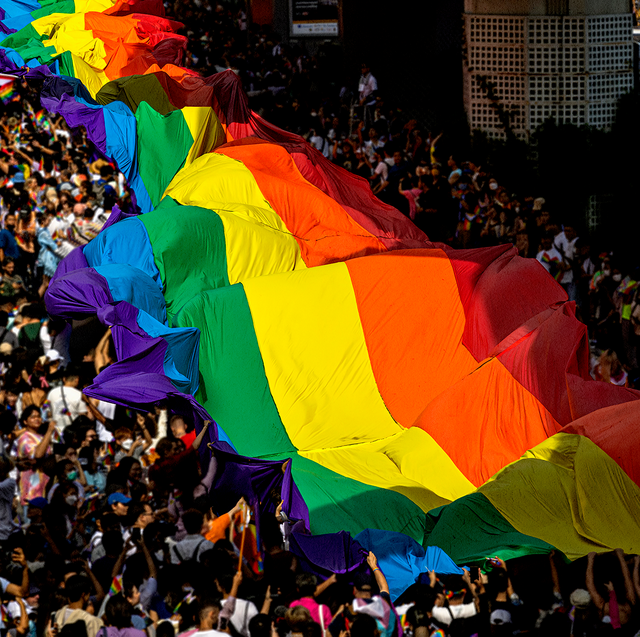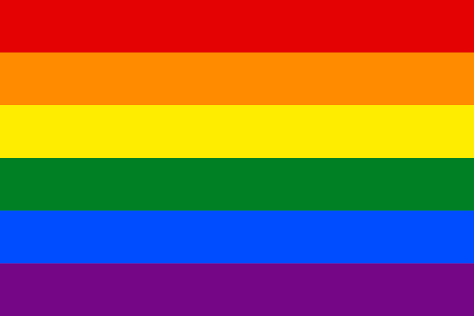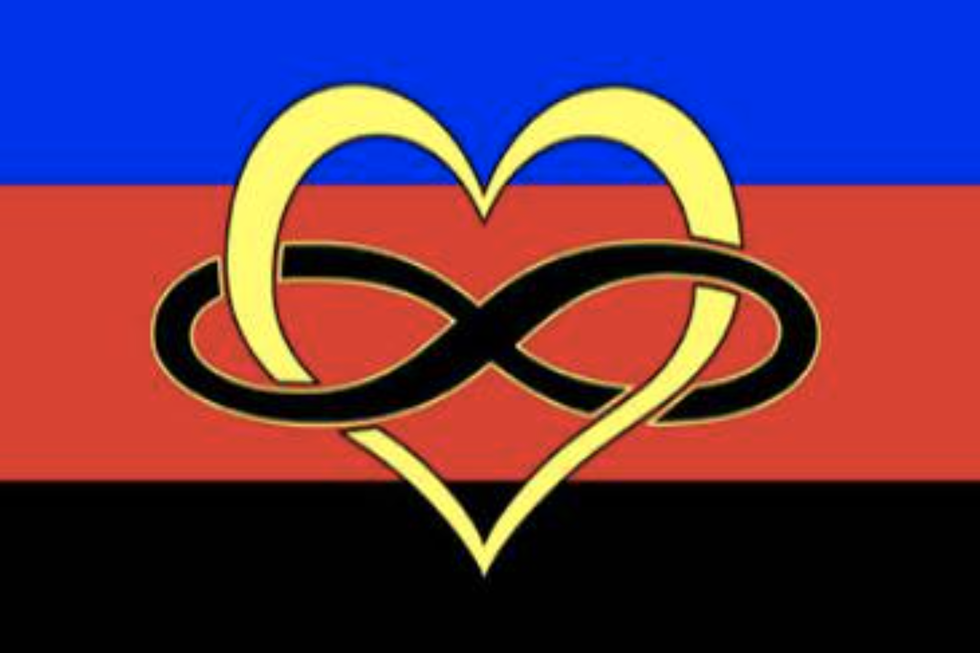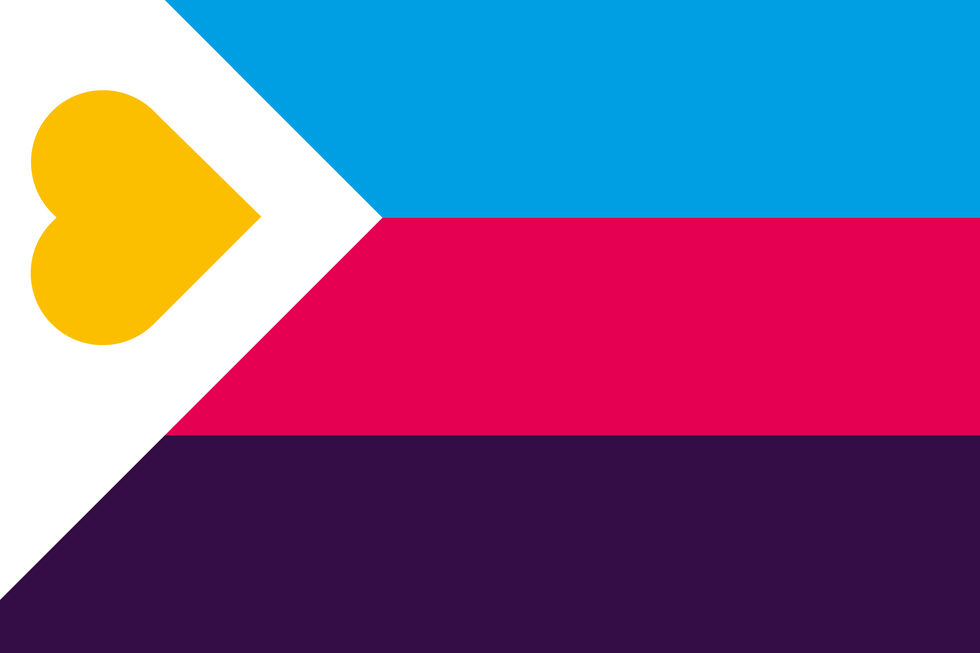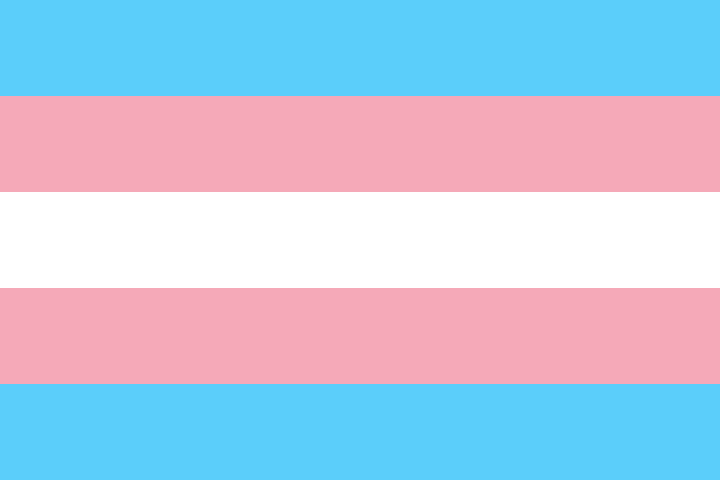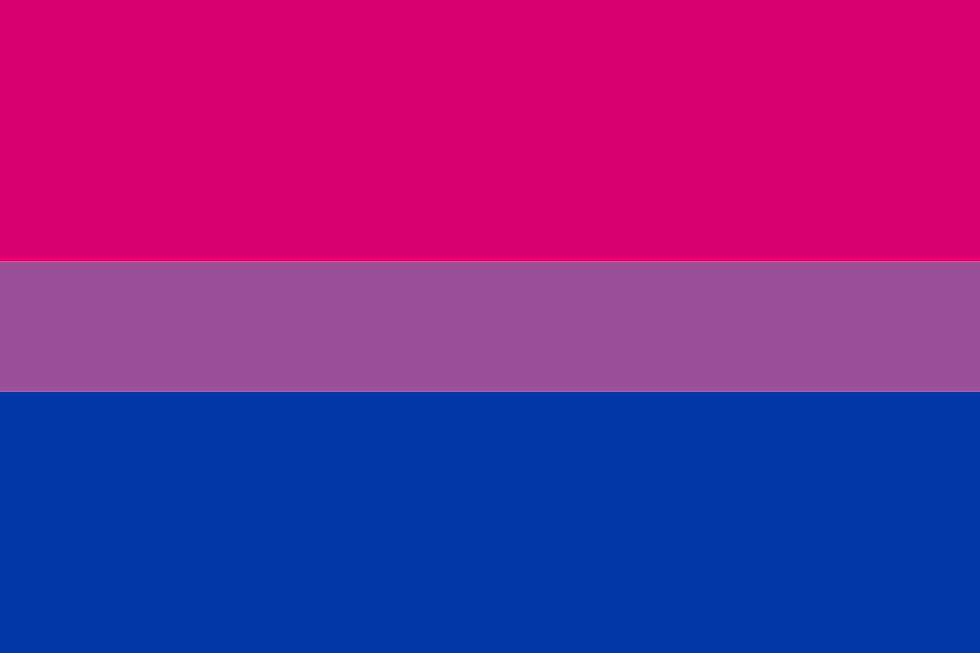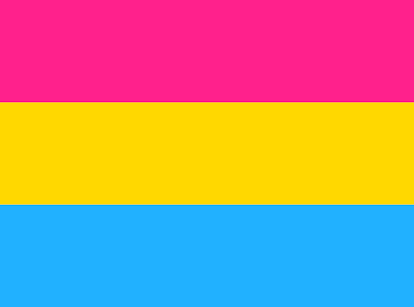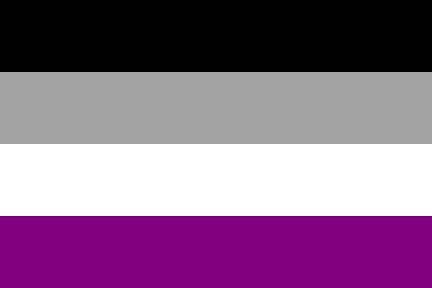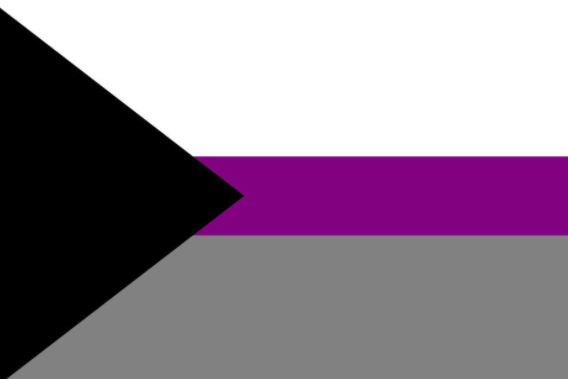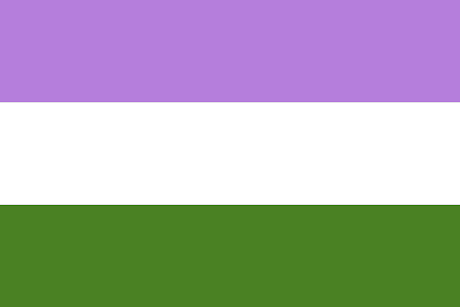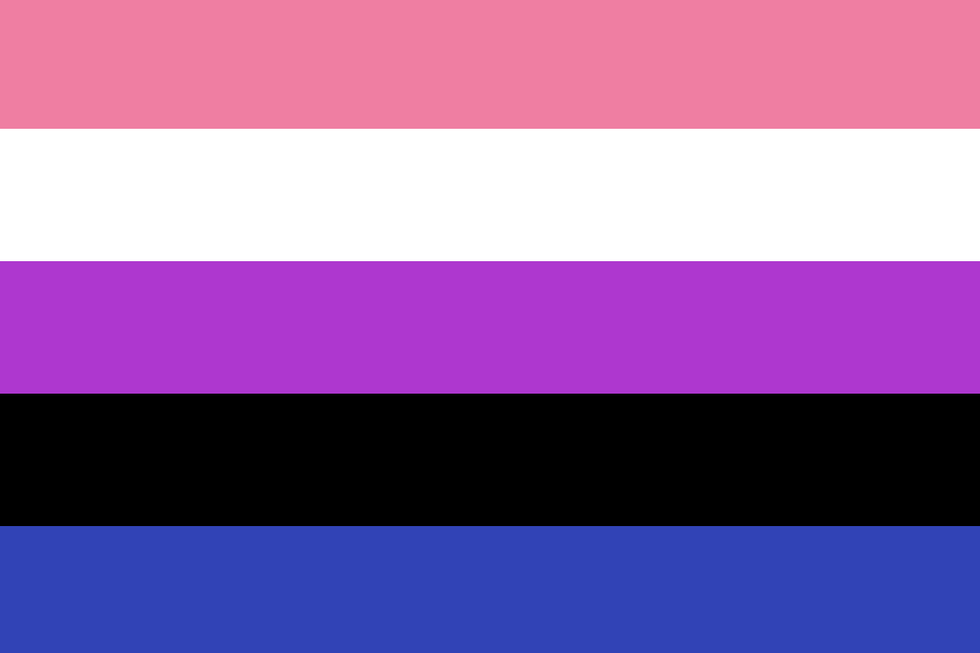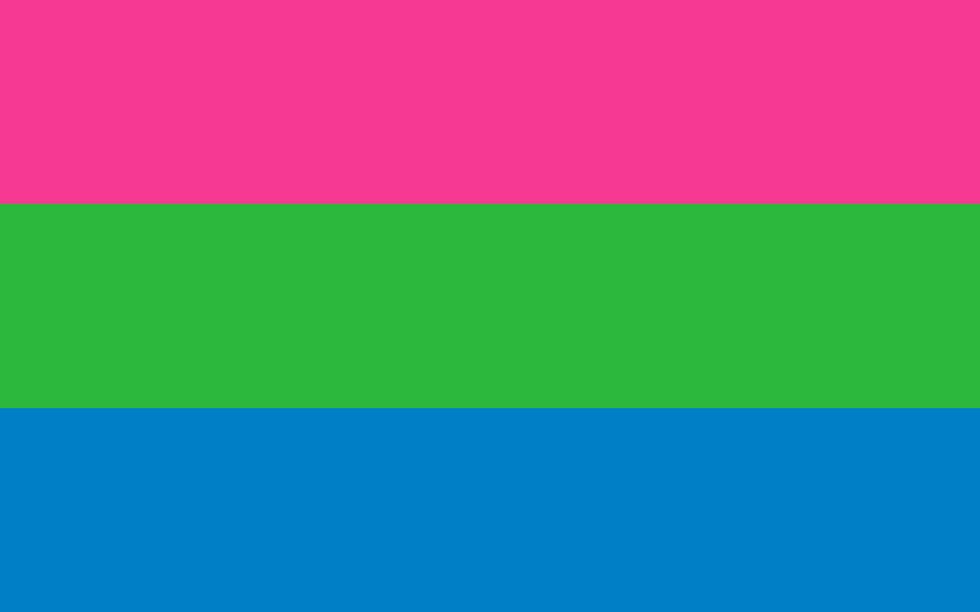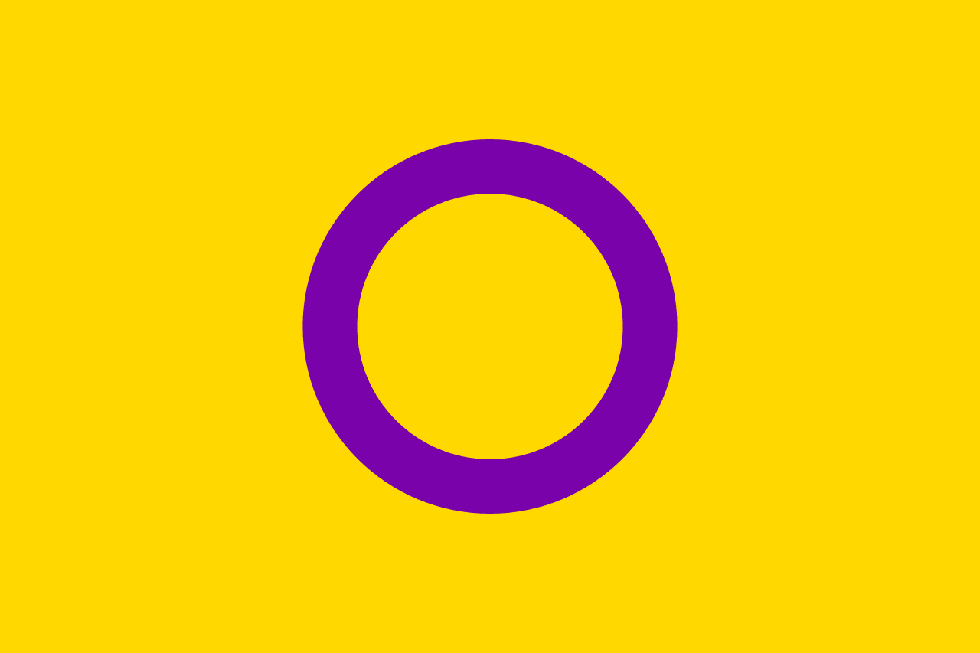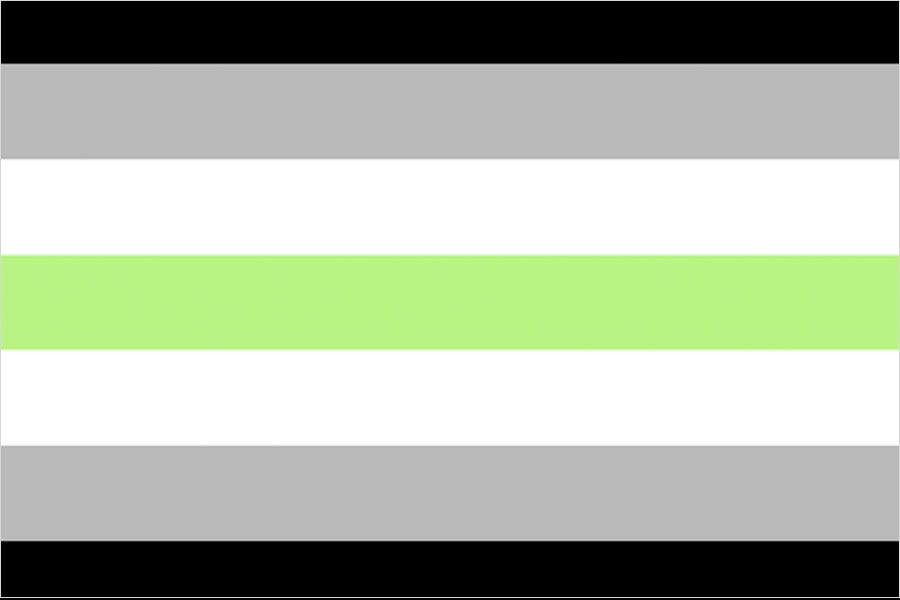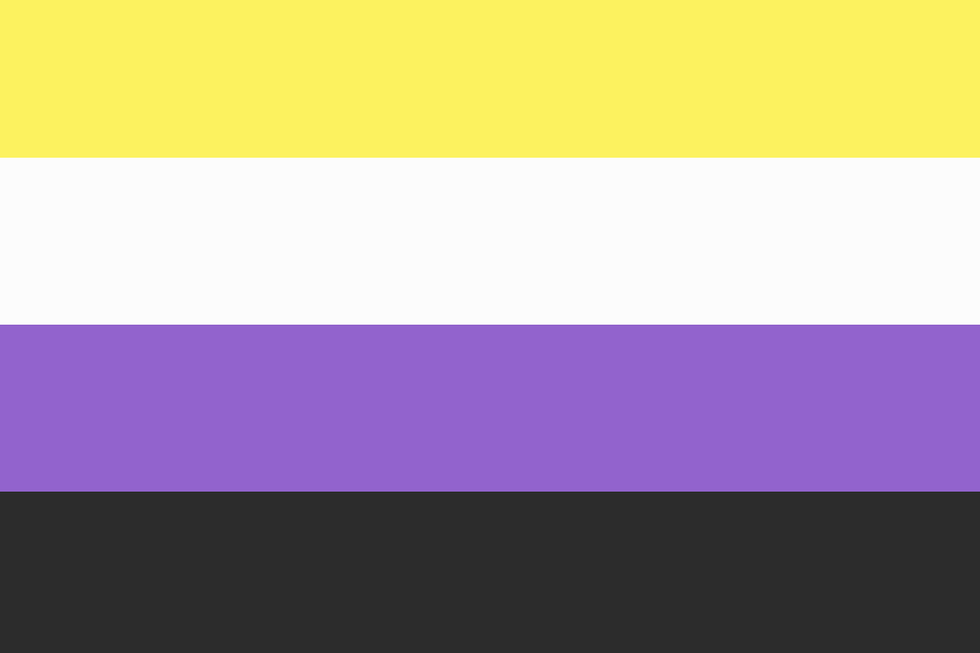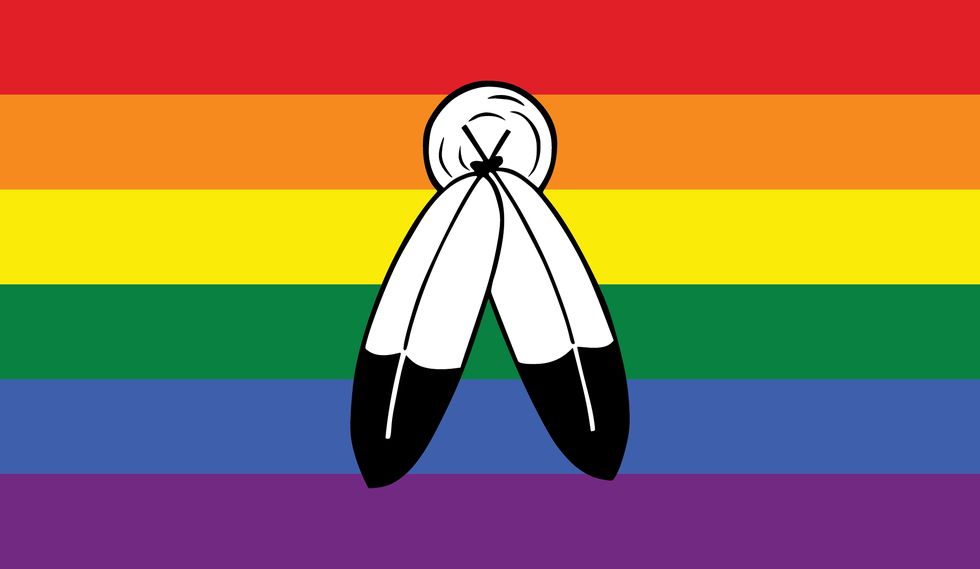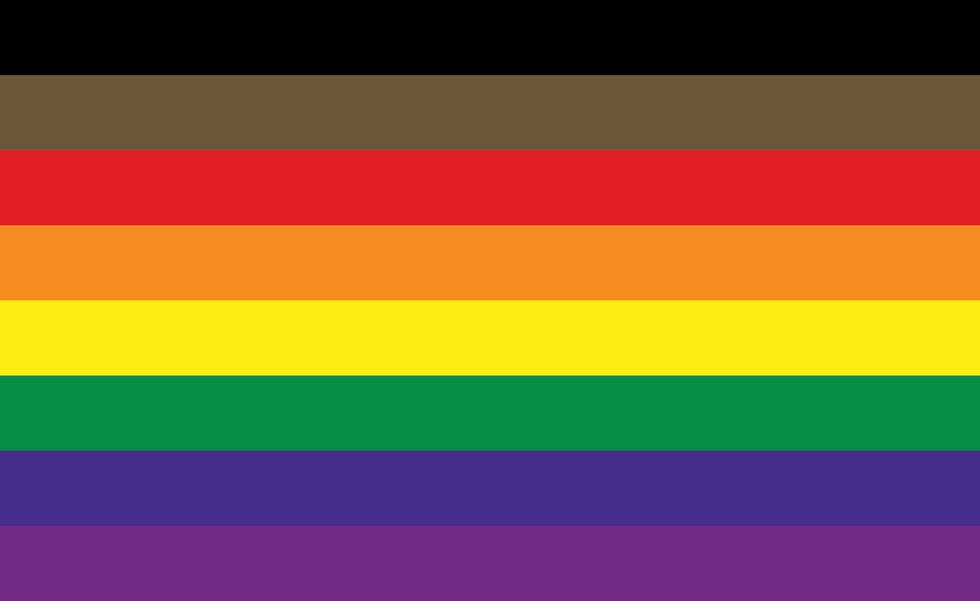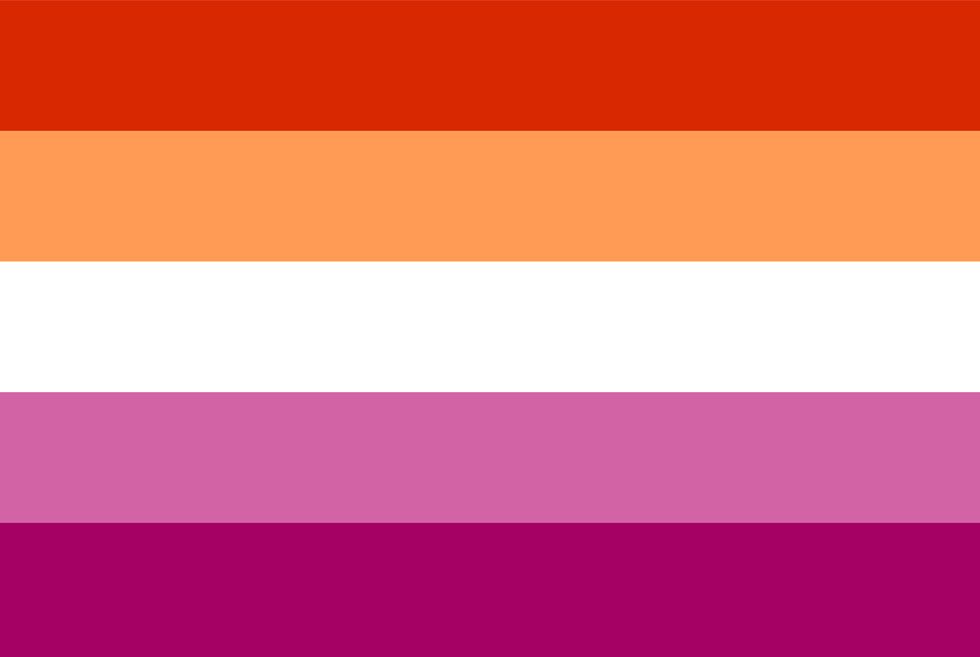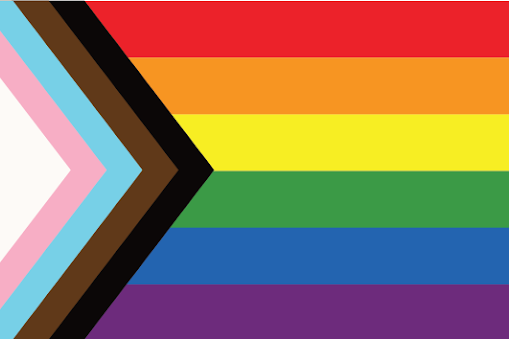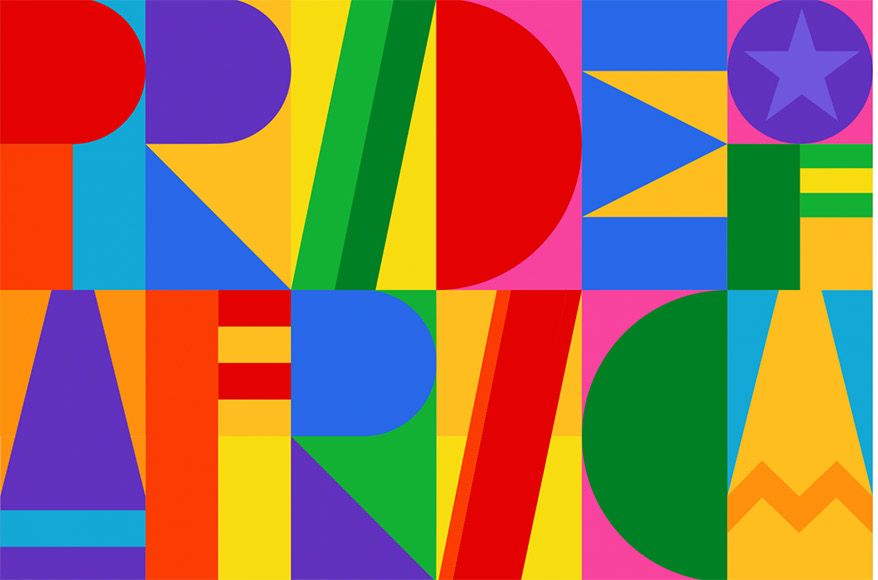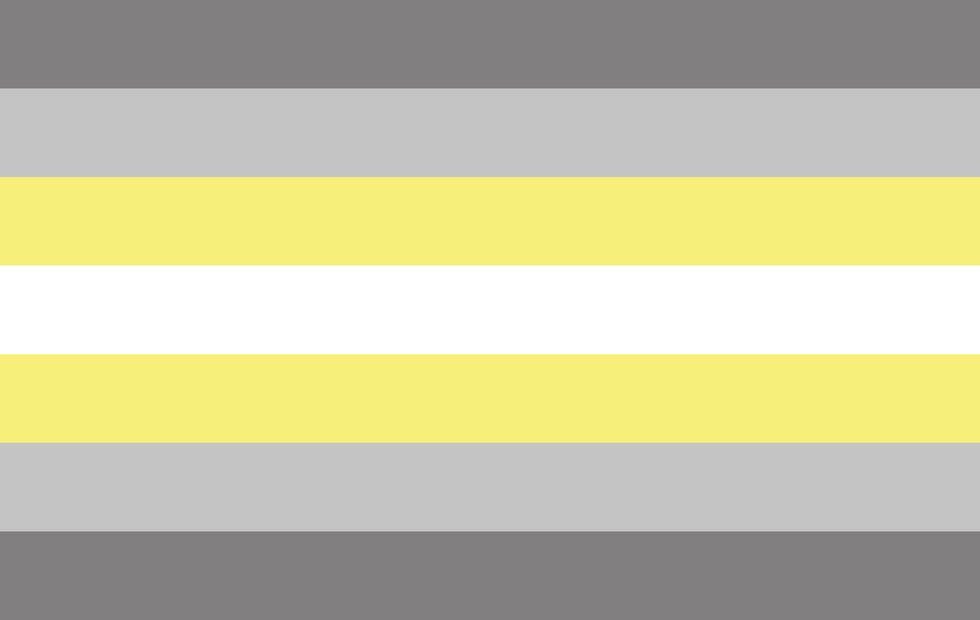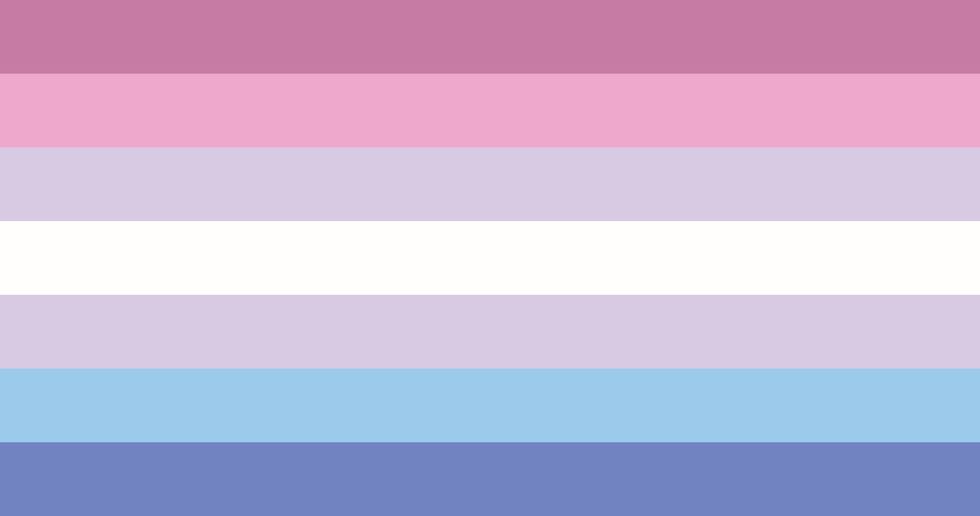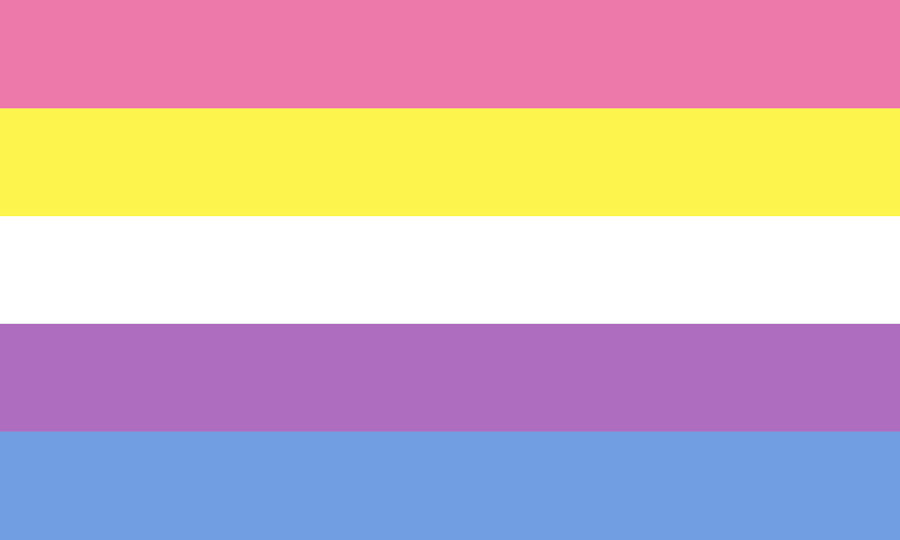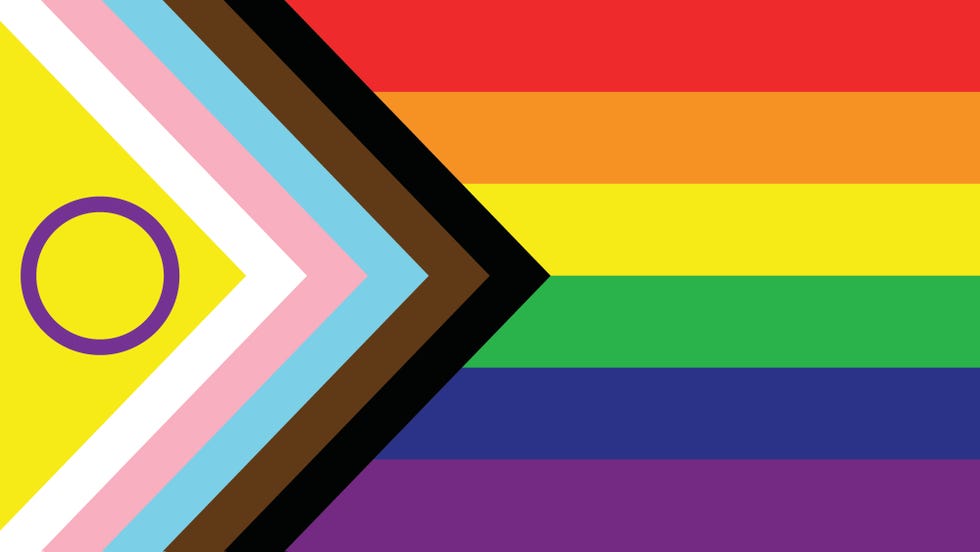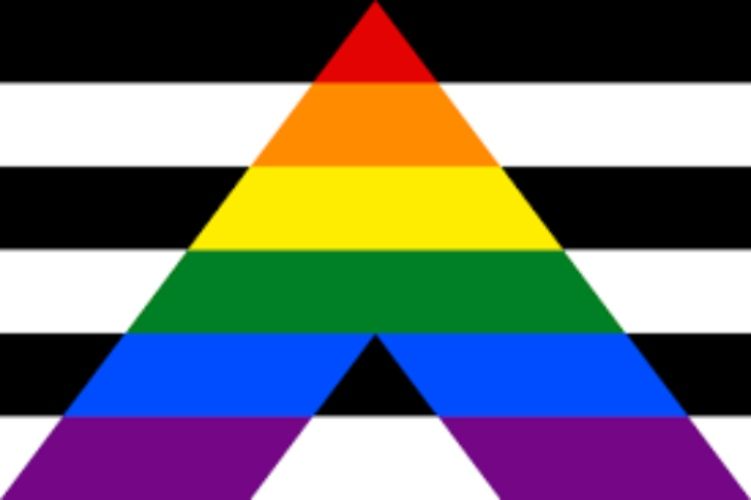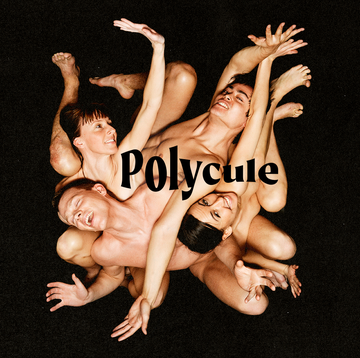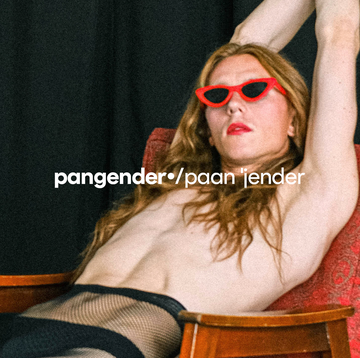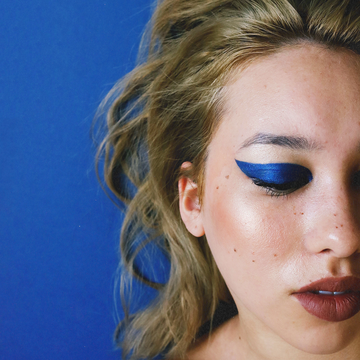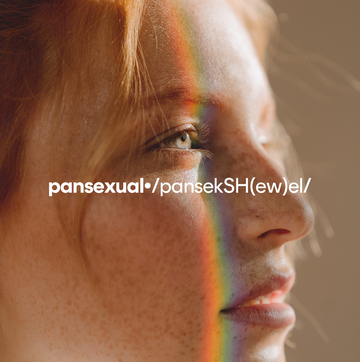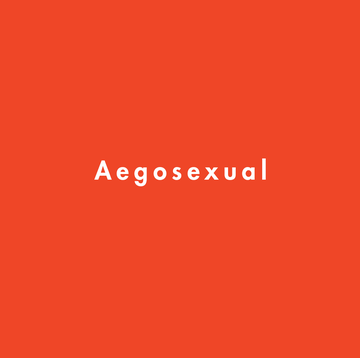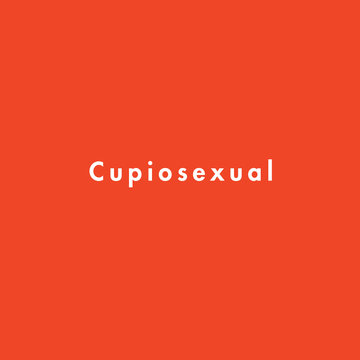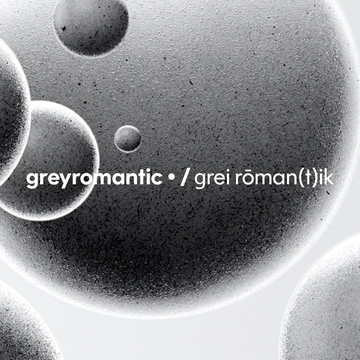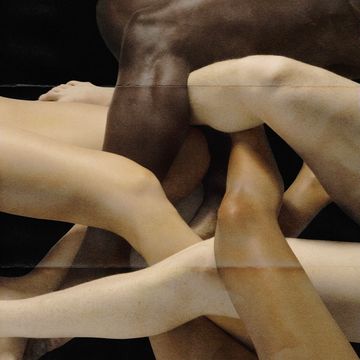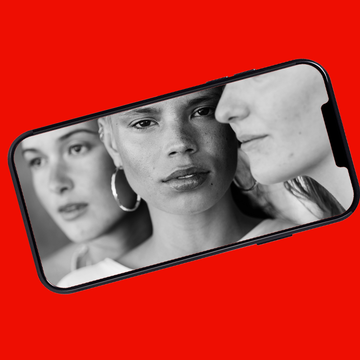When a queer person sees a Pride flag hanging from the door of a restaurant, clothing store, or nail salon, it signals that this is a safe space. While you might typically associate these flags, especially the iconic Gilbert Baker Pride Flag, with glam Pride Month parades and celebrations, the flag’s year-round role as a queer lighthouse is perhaps its most important usage given the hate, discrimination, and atrocities that members of the LGBTQIA+ community continue to face. “The Pride flag means acceptance and inclusion, and symbolizes an understanding that we get to decide and define who we are in the world, and no one else has the right to do it,” says Nicole Davis, LCSW, Clinical Director at the Gender & Sexuality Therapy Center in New York. “Whether you display the Pride flag as a member of the queer community or as an ally, it means celebration, love, chosen family, and safety.”
There are plenty of different Pride flags out there (which we’ll get into, don’t worry!), but the beloved rainbow banner is in a category all its own due to the safety and community it represents. “As a general rule, I'm not a big fan of flags,” Davis says. “I usually see them as symbols of nationalism, which makes me deeply uncomfortable. But the Pride flag feels different to me—in part, I'm sure, because I'm a member of the queer community, but also because displaying the Pride flag is a way of signaling that you are a safe space for people who have an increasingly difficult time feeling safe in this country.”
However, the rainbow flag, while adored, is just one of many symbols that LGBTQ+ communities proudly display. The Human Rights Campaign (HRC) notes at least 25 different Pride flags representing various identities and experiences within the LGBTQ+ spectrum. That includes flags for specific orientations, such as the pink, purple, and blue bi flag, as well as those for genders, like the trans flag. There are even flags for the drag community and one specifically for allies. Keep reading to brush up on their meanings and history and decide which ones you want to display this Pride Month. Remember, though, queer people deserve to feel seen and welcomed all year round, and these flags can (and should) be flown with pride 365 days a year.
The Gilbert Baker Pride Flag
The meaning: According to the late Robert Deam Tobin, PhD, who taught courses in gay and lesbian studies and queer theory at Clark University, the gay pride flag “was and is a cheerful, upbeat, optimistic, and instantly identifiable symbol of the LGBTQ+ community—and has caught on throughout the world, in big cities and little ones.” The rainbow was seen as a symbol of hope, dating back to the Bible, per artist Gilbert Baker’s 2019 memoir Rainbow Warrior.
The history: Baker’s flag was born in 1978 out of a response to activists calling for a new symbol for the gay movement. (Prior to the rainbow flag, the movement used a pink triangle in an attempt to reclaim it from how Hitler used it to place a stigma on LGBTQ+ communities during WWII.) “That was a big year for LGBTQ+ community, because Harvey Milk had been elected to office as really the first openly gay person in California to be elected there,” explains Greg Miraglia, professor of LGBT studies and criminal justice at Napa Valley College, Santa Rosa Junior College and City College of San Francisco.
Baker attempted complete inclusivity with the original eight colors in the flag—pink, red, orange, yellow, green turquoise, dark blue, and violet—with each color representing a different aspect of the human experience, like sex, life, and healing. “Baker said sexuality and gender identity are things everybody has, and so he wanted to have a symbol that was inclusive of everyone,” says Miraglia. It was pared down to six colors, dropping pink and turquoise, due to the difficulty of producing pink fabric.
The Polyamory Pride Flag
The meaning: “Polyamory is a form of consensual non monogamy that emphasizes emotional connection among multiple partners,” Elisabeth Sheff, PhD, author of The Polyamorists Next Door: Inside Multiple-Partner Relationships and Families, previously told Cosmopolitan.
The history: According to the HRC, Jim Evans designed the blue, red, and black flag in 1995 to symbolize diverse facets of polyamory, which refers to people who love (poly runs deeper than just sex) more than one partner. The color blue stands for openness, red signifies passion, and black represents solidarity with those who must conceal their polyamorous relationships due to ongoing stigma in society. Initially, the flag featured a gold pi symbol that symbolized the limitless possibilities of polyamorous partnerships. Then, in 2017, the polycommunity at the University of Northern Colorado introduced a revised version of the flag. This updated design replaces the pi symbol with a heart intertwined with an infinity sign, echoing the original theme of endless love for multiple partners.
The poly flag underwent an update once more in 2022, according to Polyamproud, after tallying the votes of 30,827 polyamorous people. The tricolor polyamory pride flag (pictured above) modernizes the traditional elements found in its predecessors while giving it a community-elected makeover. A chevron pointing towards the flag's end symbolizes growth, with its asymmetric placement reflecting the unconventional and badass nature of polyamorous relationships. A central heart emphasizes that love permeates the essence of polyamory.
The chevron is white because it represents the potential and hope (a blank space, if you will) for the non-monogamous community's future. As in the original design, magenta signifies desire and blue symbolizes openness and honesty, essential for navigating non-monogamy. Gold highlights the resilience within the community and encourages ongoing perseverance against the restriction of societal norms. Purple represents unity while honoring the contributions of People of the Global Majority and advocating for an inclusive poly scene that celebrates diversity across races, ethnicities, sexualities, and genders, per Polyamproud.
The Transgender Pride Flag
The meaning: The transgender pride flag purposely plays with the traditional colors for baby boys (light blue) and girls (light pink). The flag represents the diversity of the community in the white stripe, inclusive of those who are intersex, transitioning, or gender neutral.
The history: Monica Helms, a transgender woman, created the trans pride flag in 1998, according to OutRight International. “This flag is becoming quite well recognized, in part because the trans community has had to fight many battles: ensuring medical access, fighting discrimination in the military and elsewhere, providing resources for trans youth, taking on hostile state laws, and fighting discriminatory ballot measures,” Tobin says.
The Bisexual Pride Flag
The meaning: Like most pride flags, the colors in the bisexual pride flag—pink, purple, and blue—tell the story. According to Tobin, “the pink represents same-sex attraction, the blue represents heterosexual attraction, and the two colors fade imperceptibly into each other to create purple.”
The history: The flag was created by Michael Page in 1998, during a period marked by changes led by the community craving for more inclusivity and variation than the traditional pride flag provided for two decades. “At the end of the 1990s, you see the addition of the lesbian, trans, and bisexual flags,” said Tobin. “It's as though the 1990s was a moment of understanding the need for communities to break out and create their own identities.” Many modern bicons, such as bisexual activist and Cosmo columnist Zachary Zane, agree that the bi flag offers a welcome wave for the community. “The bisexual flag was created because many bisexual people did not feel included in gay and lesbian spaces,” Zane explains. “We were often told our (bi)sexuality was a phase or that we were confused or greedy, so many bi people didn't feel represented by the traditional rainbow pride flag. However, many bi people, myself included, do feel very represented by the bi flag. We often use the bi colors as a sort of ‘flagging,’ similar to the gay hanky code, that lets other people know we're bisexual.”
The Pansexual Pride Flag
The meaning: This pansexual flag, which visually echoes the bisexual pride flag, combines pink and blue with a yellow stripe instead of purple. Pink symbolizes attraction to femme-identifying individuals, while blue denotes attraction to those who are male-identified, and yellow represents non-binary people.
The history: “The pansexual pride flag has been around since the 2010s,” said Tobin. A modern flag, the Pansexual pride flag is largely attributed to a Tumblr post by Jasper V, a queer, non-binary individual from England.
The Asexual Pride Flag
The meaning: Despite its name, this flag is not strictly for asexual people. “Its colors are designed to include graysexuals, who operate in the ‘gray space’ between sexuality and asexuality, as well as demisexuals, who only feel sexual attraction under certain circumstances,” explains Tobin. For members of the LGBTQ+ communities and allies alike, it can seem like there are a lot of flags (and many meanings within those flags), but they simply represent different experiences. “We are a gloriously diverse group of people with a wide range of experiences, backgrounds, and identities,” says Elise Schuster, MPH, a sexuality educator and trainer on LGBTQ+ issues and co-founder of OkaySo, a free app for young people connecting them to experts they can trust. The asexual flag consists of four colors, each symbolizing a distinct aspect of the spectrum it represents: black stands for asexuality, gray signifies gray asexuality and demisexuality, and white denotes allies and partners who are not asexual. Purple represents the community.
The history: Prior to the creation of the Asexual Pride Flag, various symbols such as the ace of spades playing card and the AVEN (Asexual Visibility and Education Network) triangle were emblematic of the asexual community. This triangle was influenced by an earlier conceptual model of asexuality, with the white section representing the heterosexual-to-homosexual spectrum and the black section symbolizing asexuality. As reported by The Asexual Agenda, the flag was introduced in July 2010 after the AVEN held a contest to design it. Following three rounds of voting, the current design of the asexual flag was finalized and announced.
The Demisexual Pride Flag
The meaning: Demisexual is used to describe people who “need to feel a strong emotional connection with someone in order to feel any sexual attraction to them.” Per HRC, this flag is for people who only form sexual attraction through deep and emotional connections with potential love interests.
Again, the colors (white, purple, gray, and black) basically spell out the meaning. “Anytime you see purples, greens, and yellows in flags, these are colors that are not linked to gendered norms, so you know the flag is highlighting people who reject these binaries,”
says Hannah Simpson, a LGBTQ+ writer, speaker, and activist. With no genders represented, black, gray, and white stand for asexuality, demisexuality, and sexuality, respectively, while the purple stands for community, according to HRC.
The history: According to the Gender & Sexuality Resource Center at University of Northern Colorado, “it is unknown how or when the flag came to be, but it is very similar to the asexual flag in its use of colors.”
The Genderqueer Pride Flag
The meaning: The colors of this flag—lavender, white, and chartreuse—represent identities that constitute being genderqueer: androgyny, agender, and non-binary identities. “The Genderqueer Flag speaks to my identity,” says Michael Herkes, the author of The GLAM Witch: A Magical Manifesto of Empowerment with the Great Lilithian Arcane Mysteries, who identifies as genderqueer and gay. “Breaking down the color symbolism, the lavender sits at the top as a mixture of the traditionally gendered colors pink and blue. This symbolizes androgyny. The white strip in center mimics the trans flag and represents a spectrum of agendered identities. The green is added as it sits opposite lavender on the color wheel. It is said to represent non-binary identities.”
The history: Genderqueer advocate Marilyn Roxie created the flag in 2011, per OutRight.
The Genderfluid Pride Flag
The meaning: Five stripes adorn this flag, which “goes from pink, representing femininity, to blue, representing masculinity, and tries to cover everything in between,” according to Tobin. Black represents genderfluid individuals who don’t associate with any genders, and white includes all genders.
The history: According to OutRight International, JJ Poole added this flag to the array of pride symbols in 2012.
The Polysexual Pride Flag
The meaning: The polysexual pride flag represents people who are attracted to multiple genders, but not all genders. Blue and pink represent attraction to men and women, respectively, and the green stripe is for attraction to people who are outside of the gender binary.
The history: This pink, green, and blue flag was created online in 2012, according to HRC.
The Intersex Pride Flag
The meaning: “The intersex pride flag works with colors that have not been traditionally gendered, like yellow,” says Tobin, who says the flag has helped unify the intersex community. It’s a chance for people to bond together to fight “medical and political battles,” such as preventing premature corrective surgery before people born intersex can give their consent.
The history: Created in 2013 in Australia by Morgan Carpenter, color is key in this flag. According to Carpenter’s website, the colors in this flag “seek to completely avoid use of symbols that have anything to do with gender at all.” And the purple circle design “represents wholeness.”
The Agender Pride Flag
The meaning: Agender is a gender identity used to describe people who don’t identify as having a specific gender. According to Tobin, “This flag chooses colors that have not been traditionally gendered.” OutRight International notes “the black and white stripes represent an absence of gender, the gray represents semi-genderlessness, and the central green stripe represents non-binary genders.”
The history: Salem X created this seven-stripe flag, which debuted in 2014, per OutRight. As more flags join the original pride flag, it really illustrates how many different people make up the LGBTQ+ communities, which Schuster appreciates: “I love how it shows just how many ways there are to be in the world!”
The Non-Binary Pride Flag
The meaning: According to Tobin, this particular flag is meant to “represent people outside the traditional gender binary, people with multiple genders, people with mixed genders, and people with no genders.”
With so many flags representing different groups, it can be hard to understand where you belong as a part of the LGBTQ+ community. Schuster says that’s totally fine. “Lots of people are in between or are more than one thing, or may never have a label or a flag that they feel like fits them,” they explain. “And that's absolutely great—you don't have to have a flag you identify with to be an important part of the LGBTQ+ community.”
The history: Tobin says the non-binary flag we see today was first created by Kye Rowan in 2014.
The Drag Pride Flag
The meaning: The drag pride flag’s purple stripe represents a shared passion for drag, the blue represents expression and loyalty, and the white in the middle is a drag performer's blank slate to create their character. Atop the stripes is a five-pointed crown with stars, the crown a nod to leaders in the community, and the stars representing the many types of drag.
The history: Veranda L’Ni created the current drag pride flag for an Austin International Drag Foundation contest in 2016, according to Drag Pride. Prior to 2016, a 1999 flag featured a phoenix overlaid on a red and black and white checked pattern. Sean Campbell created the feather pride flag, and it symbolized rebirth and fires of passion.
The Two-Spirit Pride Flag
The meaning: Representing the third gender in traditional Indigenous North American communities, two-spirit individuals don’t fall within the gender binary, per SexualDiversity.org. The flag takes inspiration from the Baker pride flag, placing the image of two feathers connected by a circle atop the rainbow flag, per HRC. It symbolizes masculinity and femininity while also bringing together masculine and feminine identities into one gender.
The history: According to Queer in the World, the flag was created in 2016 based on a Tumblr request.
The Philadelphia Pride Flag
The meaning: Two new colors were added to Baker’s pride flag in 2017 and unveiled during Philadelphia's 2017 Pride event, according to the HRC. The addition of a black and a brown stripe was to acknowledge communities of color and their contributions to the LGBTQ+ rights movement. It was a response to “new developments in the LGBTQ+ community, particularly to be inclusive in terms of race and trans issues,” per Tobin.
The history: The original six-color pride flag was the main symbol for LGBTQ+ communities for decades, and while it was meant to be inclusive, the Philadelphia City Council commissioned a new flag for what they saw as overlooked communities in the movement. “The Philadelphia Pride flag resonates for me because it recognizes that for many people, Pride celebrations (and therefore the traditional Pride flag) have become white-washed symbols of corporate, capitalist interests,” says Davis. “I appreciate the centering of black and brown lives and bodies in the symbolism of Pride, since so often we are erased from both the history of Pride and the current popular narrative of what LGBTQ+ looks like.”
The Lesbian Pride Flag
The meaning: The five-stripe flag with different shades of red, pink, and orange is the newest version of the lesbian pride flag that’s been used since 2018, and Tobin explains it is “trying to signal toward diversity with the orange line suggesting gender nonconformity.”
The history: It’s been a journey to get the current flag meant to symbolize different types of femininity, per HRC. “There are actually a variety of lesbian flags,” says Tobin. “In addition to the one shown here, there is also a purple one created in 1999—ironically, or problematically, by a man.”
That particular flag was problematic because it featured “a double-edged axe, known as a labrys, set in an inverted triangle” that looked a lot like “the black triangle used to identify some lesbians in Nazi concentration camps,” per Tobin. A 2010 update featured shades of pink and a lipstick stain as an ode to “lipstick lesbians,” he says, but this new one is here to symbolize diversity.
The Progress Pride Flag
The meaning: The Progress Pride flag keeps the six colors of the original pride flag (and the black and brown from the Philadelphia flag), and it adds three more stripes: white, pink, and blue, to represent the trans community
The history: To recognize even more groups in the LGBTQ+ communities, Daniel Quasar created the Progress pride flag in 2018.. “Quasar’s version moved the black and the brown to the side as part of a triangle that also included the colors of the trans flag intersecting with the now-traditional rainbow flag,” according to Tobin.
According to the HRC, the black stripe in this flag is both a nod to communities of color and to the thousands of individuals who died in the HIV/AIDS crisis in the 1980s and 1990s.
The Trans-Inclusive Gay Men's Pride Flag
The meaning: A seven-striped flag, this is the second version of the gay men’s pride flag, according to HRC. With more shades of green and blue, it expands on the original’s three colors — green, blue and white. A wider array of colors is meant to include non-cisgender gay men.
The history: It’s not clear when the new version debuted.
The Queer People of Color Pride Flag
The meaning: According to HRC, the 2019 Queer People of Color flag represents the intersecting struggles of the fights for racial and queer equality. It overlays a fist with a gradient of colors from brown to black on the rainbow flag. The symbol became very popular during 2020 Black Lives Matter protests, and the flag is meant to give distinction to those who have fought for both queer and racial equity.
The history: Following in the Baker flag footsteps, this symbol also made its debut in San Francisco, more than 40 years later.
The Pride of Africa Flag
The meaning: According to Campaigns of the World, the flag represents the 54 African countries, and it’s “a rainbow flag that says you are accepted, you are welcome, and you are safe as it celebrates both communities and individuals without borders.”
The history: The first pan-African LGBTQ+ flag, this symbol debuted thanks to the Pride of Africa Foundation in 2019 at Johannesburg Pride in South Africa, per HRC.
The Demigender Pride Flag
The meaning: According to HRC, this flag represents people who have a partial connection to gender identity or the concept of gender altogether. It has seven stripes with gray, dark gray, yellow, and white. The grays symbolize “fragmentary connections” with gender, per Queer in the World. Yellow represents non-binary individuals, and the white is inclusive of agender identification.
The history: It’s not clear when, exactly, the flag was created.
The Bigender Pride Flag
The meaning: Representing people who have two genders, this flag has seven stripes, ranging from shades of pink to shades of blue, with white in the middle. For some, bigender can mean identifying as both male and female, but it can also be inclusive of non-binary identities, per HRC. According to SexualDiversity.org, the colors in the flag are meant to represent individuals who go between the male and female genders, or who combine them.
While this version appears most often, there is a second version of the bigender pride flag (pictured above), that only contains five stripes, one of them yellow, as a shout out to bigender babies whose gender is neither masculine or feminine.
The history: It’s not clear when the flag was created.
The Intersex-Inclusive Pride Flag
The meaning: According to the Consortium of Lesbian, Gay, Bisexual and Transgender Voluntary and Community Organisations, Valentino Vecchietti debuted this flag as part of Intersex Equality Rights UK's Intersex Visibility and Inclusion campaign, and it combines the 2013 intersex flag with the 2018 progress pride flag.
The history: Vecchietti created this flag in 2021, and it includes the intersex community in the progress pride flag. As of May 2023, it’s the most updated pride flag, but if past iterations of the flag are any indication, it may not be the last. “We're all a part of this larger community, but the individual ways we identify are also important to us,” Schuster explains. “Being able to have a visual symbol of that can feel very empowering.”
The Straight Ally Flag
The meaning: While, as long as you are respectful, it's generally okay for allies to use other flags as a means of signaling inclusivity (such as hanging a rainbow flag outside your business to show that all are welcome), there is a flag made specifically for allies. Designed with an "A" for ally set against a black and white background, this flag provides a way for non-queer allies to visibly demonstrate their support while respecting the flags uniquely created specifically for the queer community by its members.
The history: This flag is said to have started in the late 2000s, although like so many flags, its origins are still somewhat ambiguous.
Taylor is the former Sex and Relationships editor who can tell you exactly which vibrators are worth the splurge, why you’re still dreaming about your ex, and tips on how to have the best sex of your life (including what word you should spell with your hips during cowgirl sex). You can follow her on Instagram here.

Collette is a freelance writer and editor who covers entertainment, travel, food, health, tech, and trends. She was previously an Experiences Editor at Elite Daily. You can follow her on Instagram at @collette.reitz and Twitter at @collette_reitz.
